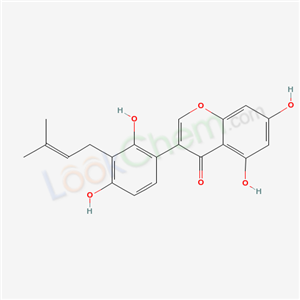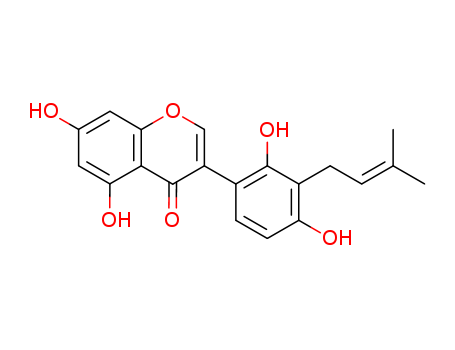Technology Process of Licoisoflavone A
There total 8 articles about Licoisoflavone A which
guide to synthetic route it.
The literature collected by LookChem mainly comes from the sharing of users and the free literature resources found by Internet computing technology. We keep the original model of the professional version of literature to make it easier and faster for users to retrieve and use. At the same time, we analyze and calculate the most feasible synthesis route with the highest yield for your reference as below:
synthetic route:
- Guidance literature:
-
With
sodium hydroxide;
In
methanol;
at 50 ℃;
for 1.5h;
DOI:10.1246/bcsj.58.136
- Guidance literature:
-
Multi-step reaction with 4 steps
1: 97 percent / hydrogenolyse / 10percent Pd-C / methanol
2: 37 percent / pyridine / diethyl ether / 5.5 h / 2 - 5 °C
3: 18 percent / BF3-etherate / dioxane / 6 h / 51 - 53 °C
4: 50 percent / 4percent aq. NaOH / methanol / 1.5 h / 50 °C
With
pyridine; sodium hydroxide; hydrogenolyse; boron trifluoride diethyl etherate;
palladium on activated charcoal;
In
1,4-dioxane; methanol; diethyl ether;
DOI:10.1246/bcsj.58.136
- Guidance literature:
-
Multi-step reaction with 7 steps
1: 68 percent / piperidine / ethanol / 6 h / Heating
2: sodium acetate;
3: 79 percent / 1) thallium (III)nitrate trihydrate; 2) 10percent hydrochloric acid; / methanol / 1) 32-35 deg C; 8 h; 2) reflux; 3 h;
4: 97 percent / hydrogenolyse / 10percent Pd-C / methanol
5: 37 percent / pyridine / diethyl ether / 5.5 h / 2 - 5 °C
6: 18 percent / BF3-etherate / dioxane / 6 h / 51 - 53 °C
7: 50 percent / 4percent aq. NaOH / methanol / 1.5 h / 50 °C
With
piperidine; pyridine; hydrogenchloride; sodium hydroxide; hydrogenolyse; boron trifluoride diethyl etherate; sodium acetate; thallium(III) nitrate;
palladium on activated charcoal;
In
1,4-dioxane; methanol; diethyl ether; ethanol;
DOI:10.1246/bcsj.58.136





